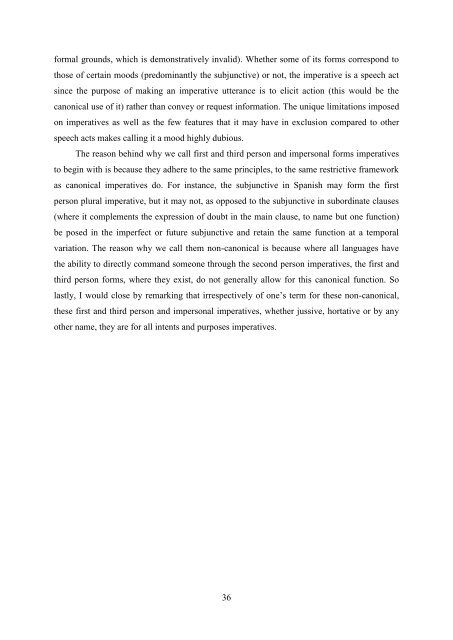The function of non-canonical imperatives in the languages of Europe
The function of non-canonical imperatives in the languages of Europe
The function of non-canonical imperatives in the languages of Europe
You also want an ePaper? Increase the reach of your titles
YUMPU automatically turns print PDFs into web optimized ePapers that Google loves.
formal grounds, which is demonstratively <strong>in</strong>valid). Whe<strong>the</strong>r some <strong>of</strong> its forms correspond to<br />
those <strong>of</strong> certa<strong>in</strong> moods (predom<strong>in</strong>antly <strong>the</strong> subjunctive) or not, <strong>the</strong> imperative is a speech act<br />
s<strong>in</strong>ce <strong>the</strong> purpose <strong>of</strong> mak<strong>in</strong>g an imperative utterance is to elicit action (this would be <strong>the</strong><br />
ca<strong>non</strong>ical use <strong>of</strong> it) ra<strong>the</strong>r than convey or request <strong>in</strong>formation. <strong>The</strong> unique limitations imposed<br />
on <strong>imperatives</strong> as well as <strong>the</strong> few features that it may have <strong>in</strong> exclusion compared to o<strong>the</strong>r<br />
speech acts makes call<strong>in</strong>g it a mood highly dubious.<br />
<strong>The</strong> reason beh<strong>in</strong>d why we call first and third person and impersonal forms <strong>imperatives</strong><br />
to beg<strong>in</strong> with is because <strong>the</strong>y adhere to <strong>the</strong> same pr<strong>in</strong>ciples, to <strong>the</strong> same restrictive framework<br />
as ca<strong>non</strong>ical <strong>imperatives</strong> do. For <strong>in</strong>stance, <strong>the</strong> subjunctive <strong>in</strong> Spanish may form <strong>the</strong> first<br />
person plural imperative, but it may not, as opposed to <strong>the</strong> subjunctive <strong>in</strong> subord<strong>in</strong>ate clauses<br />
(where it complements <strong>the</strong> expression <strong>of</strong> doubt <strong>in</strong> <strong>the</strong> ma<strong>in</strong> clause, to name but one <strong>function</strong>)<br />
be posed <strong>in</strong> <strong>the</strong> imperfect or future subjunctive and reta<strong>in</strong> <strong>the</strong> same <strong>function</strong> at a temporal<br />
variation. <strong>The</strong> reason why we call <strong>the</strong>m <strong>non</strong>-ca<strong>non</strong>ical is because where all <strong>languages</strong> have<br />
<strong>the</strong> ability to directly command someone through <strong>the</strong> second person <strong>imperatives</strong>, <strong>the</strong> first and<br />
third person forms, where <strong>the</strong>y exist, do not generally allow for this ca<strong>non</strong>ical <strong>function</strong>. So<br />
lastly, I would close by remark<strong>in</strong>g that irrespectively <strong>of</strong> one’s term for <strong>the</strong>se <strong>non</strong>-ca<strong>non</strong>ical,<br />
<strong>the</strong>se first and third person and impersonal <strong>imperatives</strong>, whe<strong>the</strong>r jussive, hortative or by any<br />
o<strong>the</strong>r name, <strong>the</strong>y are for all <strong>in</strong>tents and purposes <strong>imperatives</strong>.<br />
36
















